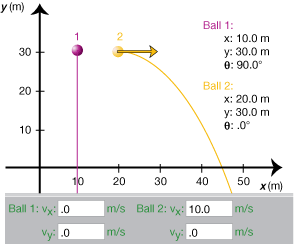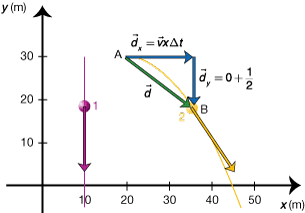Module 2—Motion in Two Dimensions
 Lesson 3 Lab: Projectile Motion—Two Balls
Lesson 3 Lab: Projectile Motion—Two Balls
Introduction
The Projectile Motion: Two Balls simulation used for this lab shows two balls performing simultaneous projectile motions.
This simulation lets you see how gravity affects projectiles. You can learn more about the simulation and how to use it by reading the Show Me found at the top of the simulation screen.
Problem
Does the horizontal velocity of a projectile affect the time that a projectile will be in the air?
Open the simulation; then continue with the procedure.
Procedure
Test your prediction using the projectile simulation.

- On the simulation, click the “Reset” button (
 ). You may have to drag the bottom border of the window down to see the labels on the buttons.
). You may have to drag the bottom border of the window down to see the labels on the buttons.
- Set the position and velocity of each ball as follows:
- Position ball 1 at (x, y) = (10.0, 30.0) m by clicking on it and dragging it to that position. Click the “Data” button (
 ) at the bottom to display the exact coordinates. You can then click and drag the left ball to the desired position.
) at the bottom to display the exact coordinates. You can then click and drag the left ball to the desired position.
- Position ball 2 at (x, y) = (20.0, 30.0) m.
- Set the velocity of each ball as follows:
ball 1 (purple): vx = 0.0 m/s and vy = 0.0 m/s
ball 2 (orange): vx = 10.0 m/s and vy = 0.0 m/s.
- Press “Enter.”
- Position ball 1 at (x, y) = (10.0, 30.0) m by clicking on it and dragging it to that position. Click the “Data” button (
Display the balls’ paths by clicking the “Trace” button (![]() ) and “Play” button (
) and “Play” button (![]() ). Watch the simulation to verify which ball reaches the x-axis first. Press the “Pause” button (
). Watch the simulation to verify which ball reaches the x-axis first. Press the “Pause” button (![]() ) to stop the action.
) to stop the action.
Observation and Analysis
LAB 1. Do both balls reach the x-axis at the same time? On the simulation, select “Rewind” (![]() ), and set the step timer (
), and set the step timer (![]() ) to 0.02 s. Select the “Play” button, and then pause it when the balls near the x-axis. Step through the motion by repeatedly pressing the “Step” button (
) to 0.02 s. Select the “Play” button, and then pause it when the balls near the x-axis. Step through the motion by repeatedly pressing the “Step” button (![]() ).If you do not have the “Data” button (
).If you do not have the “Data” button (![]() ) clicked, do so to display the exact coordinates. Record the time required for each ball to reach the x-axis.
) clicked, do so to display the exact coordinates. Record the time required for each ball to reach the x-axis.
-
time for ball 1 to reach the x-axis __________
-
time for ball 2 to reach the x-axis __________
 Module 2: Lesson 3 Assignment
Module 2: Lesson 3 Assignment
Remember to submit the answers to LAB 2 and LAB 3 to your teacher as part of your Module 2: Lesson 3 Assignment.
LAB 2. Do both balls have the same vertical (vy) component of velocity when they reach the x-axis? On the simulation, select “Rewind.” Select the “Play” button, and then pause it when the balls near the x-axis. Step through the motion by repeatedly pressing the “Step” button (![]() ). Record the vertical velocity (vy) of each ball when they reach the x-axis.
). Record the vertical velocity (vy) of each ball when they reach the x-axis.
- vertical component of velocity (vy) when ball 1 reaches the x-axis ____
- vertical component of velocity (vy) when ball 2 reaches the x-axis ____
LAB 3. Will a change in the horizontal velocity affect the vertical motion of ball 2? On the simulation, select “Rewind” (![]() ). Increase the horizontal velocity of ball 2 to 20.0 m/s. Step through the motion by repeatedly pressing the “Step” button (
). Increase the horizontal velocity of ball 2 to 20.0 m/s. Step through the motion by repeatedly pressing the “Step” button (![]() ). Again, record the vertical velocity (vy) of each ball when they reach the x-axis.
). Again, record the vertical velocity (vy) of each ball when they reach the x-axis.
-
vertical component of velocity (vy) when ball 1 reaches the x-axis ____
-
vertical component of velocity (vy) when ball 2 reaches the x-axis ____
-
Did the vertical motion of ball 2 change? Explain why or why not.
Lab Summary
In this lab you explored whether the horizontal velocity of a projectile will affect the time that a projectile will be in the air.

The two balls reach the x-axis at the same time and with the same vertical component of velocity. Thus, the vertical motions are identical. You can confirm this by observing the values of the vertical position (y) and vertical velocity (vy) of each ball at any time during the projectile motion. They will always be the same for the two balls. In contrast, the horizontal (x) components of velocity of the two balls are different. While ball 2 travels horizontally at a uniform speed, ball 1 does not move horizontally.
The motion of ball 2 is characterized by two independent motions at the same time:
-
horizontal motion with constant velocity (vx)
-
vertical motion with constant acceleration (ay)
The two motions are independent of each other. This is illustrated by the blue vectors in the image. The net displacement (![]() ) of ball 2 in going from position A to position B is the vector sum of the ball's horizontal displacement and vertical displacement. These two displacements are defined differently because one is accelerating while the other is not.
) of ball 2 in going from position A to position B is the vector sum of the ball's horizontal displacement and vertical displacement. These two displacements are defined differently because one is accelerating while the other is not.
- horizontal displacement

- vertical displacement

These two displacements are progressing simultaneously as ball 2 is moving along the orange trajectory.
As the equations for the displacements indicate, the horizontal displacement proceeds with constant velocity equal to vx and the vertical displacement with constant acceleration equal to ay.